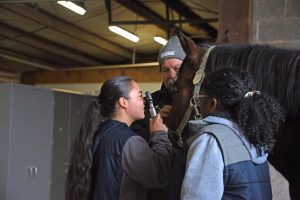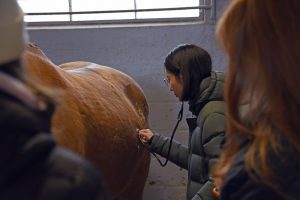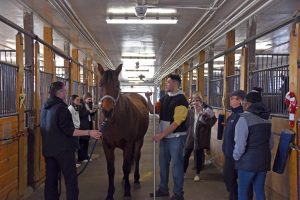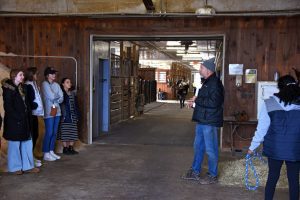Lighting and Your Horse
Author: Jenifer Nadeau, M.S., Ph.D
Jenifer.Nadeau@uconn.edu
Reviewers: Debra Hagstrom, Extension Specialist, Illinois Extension and Barbara Murphy DVM, Head of Equine Science at UCD
Publication # EXT067 | June 2024
 Circadian and circannual regulation in the horse refers to the internal timing in the equine athlete. A circadian rhythm lasts approximately 24 hours and exists under constant conditions. It can be synchronized by external signals (light/dark the most important) and is endogenously (within the body) generated. It is unaffected by changes in temperature. Feeding and exercise schedules are secondary cues that help synchronize circadian rhythms. Nearly half of all genes are turned on and off rhythmically in a circadian manner somewhere in the body. A circannual rhythm lasts approximately 365 days and also persists under constant conditions. The circannual rhythm can be synchronized by external signals, such as light. Weather conditions have a secondary impact, as do higher levels of nutrition.
Circadian and circannual regulation in the horse refers to the internal timing in the equine athlete. A circadian rhythm lasts approximately 24 hours and exists under constant conditions. It can be synchronized by external signals (light/dark the most important) and is endogenously (within the body) generated. It is unaffected by changes in temperature. Feeding and exercise schedules are secondary cues that help synchronize circadian rhythms. Nearly half of all genes are turned on and off rhythmically in a circadian manner somewhere in the body. A circannual rhythm lasts approximately 365 days and also persists under constant conditions. The circannual rhythm can be synchronized by external signals, such as light. Weather conditions have a secondary impact, as do higher levels of nutrition.
Nearly 30 percent of natural daylight is blue light. Incandescent bulbs are primarily within the orange/yellow light spectrum, and fluorescent bulbs have very little blue light. Mares have traditionally been held under lights to simulate a longer day length, with the intended goal of inducing earlier ovulations, and also promote hair coat shedding, mimicking the longer days of spring. The Equilume light mask, developed by Irish researcher Barbara A. Murphy, DVM, emits blue light into just one eye, researchers found it worked just as well as bright 200 watt barn lighting at influencing hormone rhythms in the horse. Murphy’s research team showed mares that wore light masks during the last 100 days of pregnancy had shorter gestation lengths, and delivered foals that were 8.4 lb heavier, stood 15 minutes faster, and had shorter, finer hair coats. All of these benefits were attributed to the mare’s experiencing a longer day length prior to foaling that mimics the longer days of spring.
To maintain a summer coat in a show horse, horse owners can start using blue light therapy before July 21 in the Northern hemisphere, extending long summer days for the horse. Blue light therapy can also be used to shed out a winter coat earlier in the year. Keep in mind that it takes six weeks for an animal to respond to a change in lighting. In addition to lighting, better coat condition is linked to warm stables where horses are fed well.

The benefit of using red light in horse barns when doing nighttime chores was another interesting finding by Murphy’s and her colleagues. Unlike white light, red light does not disrupt sleep rhythms such as those for melatonin. Horses are prey animals that react to threat and when bright lights are turned on after dark, it makes them more reactive. Using red light yields less intrusive nighttime interactions and facilitates a better appetite and more rest overnight.
Exercise is another known synchronizer of circadian rhythms. Exercise synchronizes gene expression in equine skeletal muscle and regulates muscle metabolism. It was found that, when training routinely occurs at a specific hour of the day, the horse’s circadian rhythm becomes set to yield optimal muscle performance at that precise time of training. It’s thought that competing or performing strenuous exercise at a time that disagrees with the normal training time might increase the risk of injuries. Research found that when traveling with horses to areas with a very different day length from where the horse resides, horses will perform better at the destination if they perform as soon as they arrive, or three to four weeks after arrival. Many give a horse one week to acclimate to the new place, but research findings suggest thi
s not to be optimal for performance, as circadian rhythms need time to shift to the new light-dark cycle. Human travelers experience this issue as jet lag.
The use of blue light therapy can reduce the number of short winter days a horse experiences, but the animal does need to experience a typical winter day length at some point. Because of the horse’s internal circannual rhythm, allowing the horse to ‘see’ winter will reboot the horse’s body clock so it will again physiologically respond well to the longer days of spring and summer. Therefore, owners should NOT expose their horses to artificially created summertime day length all winter long.

 Every day, new discoveries are made that benefit the equine industry. University of Connecticut equine extension specialists, professors and researchers are constantly working to improve horse health and well-being.
Every day, new discoveries are made that benefit the equine industry. University of Connecticut equine extension specialists, professors and researchers are constantly working to improve horse health and well-being.
Additional Resources
Murphy B.A. Circadian and Circannual Regulation in the Horse: Internal Timing in an Elite Athlete. Journal of Equine Veterinary Science 76 (2019): 14-24.
Murphy B.A., Walsh C.M., Woodward E.M., Prendergast R.L., Ryle J.P. Fallon L.H., et al. Blue light from individual light masks directed at a single eye advances the breeding season in mares. Equine Veterinary Journal 46 (2014): 23, 448-500.
Consult and follow pesticide labels for registered uses. To avoid potential phytotoxicity problems, spot test before widespread use. No discrimination is intended for any products not listed
The information in this document is for educational purposes only. The recommendations contained are based on the best available knowledge at the time of publication. Any reference to commercial products, trade or brand names is for information only, and no endorsement or approval is intended. UConn Extension does not guarantee or warrant the standard of any product referenced or imply approval of the product to the exclusion of others which also may be available. The University of Connecticut, UConn Extension, College of Agriculture, Health and Natural Resources is an equal opportunity program provider and employer.